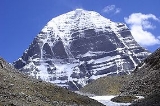
Mount Kailash
Encyclopedia
- Kailasa redirects here. For the band, see Kailasa (band)Kailasa (band)Kailasa is an Indian fusion band, founded by Kailash Kher. The name of the band is taken from an accented pronunciation of Kailash's own name as well as Mount Kailash, the abode of Hindu God Shiva...
Mount Kailash (also Mount Kailas; , Kangrinboqê or Gang Rinpoche
Rinpoche
Rinpoche or Rinboqê is an honorific used in Tibetan Buddhism. It literally means "precious one," and is used to address or describe Tibetan lamas and other high-ranking or respected teachers. This honor is generally bestowed on reincarnated lamas, or Tulkus, by default...
; Sanskrit
Sanskrit
Sanskrit , is a historical Indo-Aryan language and the primary liturgical language of Hinduism, Jainism and Buddhism.Buddhism: besides Pali, see Buddhist Hybrid Sanskrit Today, it is listed as one of the 22 scheduled languages of India and is an official language of the state of Uttarakhand...
: , Kailāsa Parvata; simplified Chinese
Chinese language
The Chinese language is a language or language family consisting of varieties which are mutually intelligible to varying degrees. Originally the indigenous languages spoken by the Han Chinese in China, it forms one of the branches of Sino-Tibetan family of languages...
: , Gāngrénbōqí fēng) is a peak in the Gangdisê Mountains, which are part of the Himalayas in Tibet
Tibet Autonomous Region
The Tibet Autonomous Region , Tibet or Xizang for short, also called the Xizang Autonomous Region is a province-level autonomous region of the People's Republic of China , created in 1965....
. It lies near the source
Source (river or stream)
The source or headwaters of a river or stream is the place from which the water in the river or stream originates.-Definition:There is no universally agreed upon definition for determining a stream's source...
of some of the longest river
River
A river is a natural watercourse, usually freshwater, flowing towards an ocean, a lake, a sea, or another river. In a few cases, a river simply flows into the ground or dries up completely before reaching another body of water. Small rivers may also be called by several other names, including...
s in Asia: the Indus River
Indus River
The Indus River is a major river which flows through Pakistan. It also has courses through China and India.Originating in the Tibetan plateau of western China in the vicinity of Lake Mansarovar in Tibet Autonomous Region, the river runs a course through the Ladakh district of Jammu and Kashmir and...
, the Sutlej River (a major tributary of the Indus River
Indus River
The Indus River is a major river which flows through Pakistan. It also has courses through China and India.Originating in the Tibetan plateau of western China in the vicinity of Lake Mansarovar in Tibet Autonomous Region, the river runs a course through the Ladakh district of Jammu and Kashmir and...
), the Brahmaputra River
Brahmaputra River
The Brahmaputra , also called Tsangpo-Brahmaputra, is a trans-boundary river and one of the major rivers of Asia. It is the only Indian river that is attributed the masculine gender and thus referred to as a in Indo-Aryan languages and languages with Indo-Aryan influence...
, and the Karnali River (a tributary of the Ganges River
Ganges River
The Ganges or Ganga, , is a trans-boundary river of India and Bangladesh. The river rises in the western Himalayas in the Indian state of Uttarakhand, and flows south and east through the Gangetic Plain of North India into Bangladesh, where it empties into the Bay of Bengal. By discharge it...
). It is considered a sacred place in four religions: Bön, Buddhism
Buddhism
Buddhism is a religion and philosophy encompassing a variety of traditions, beliefs and practices, largely based on teachings attributed to Siddhartha Gautama, commonly known as the Buddha . The Buddha lived and taught in the northeastern Indian subcontinent some time between the 6th and 4th...
, Hinduism
Hinduism
Hinduism is the predominant and indigenous religious tradition of the Indian Subcontinent. Hinduism is known to its followers as , amongst many other expressions...
, Jainism
Jainism
Jainism is an Indian religion that prescribes a path of non-violence towards all living beings. Its philosophy and practice emphasize the necessity of self-effort to move the soul towards divine consciousness and liberation. Any soul that has conquered its own inner enemies and achieved the state...
. In Hinduism, it is considered to be the abode of Lord Shiva
Shiva
Shiva is a major Hindu deity, and is the destroyer god or transformer among the Trimurti, the Hindu Trinity of the primary aspects of the divine. God Shiva is a yogi who has notice of everything that happens in the world and is the main aspect of life. Yet one with great power lives a life of a...
and a place of eternal bliss. The mountain lies near Lake Manasarowar
Lake Manasarovar
Lake Manasarovar, Mapam Yumco , or Manasa Sarovar/Lake Manas , is a fresh-water lake in Tibet Autonomous Region of China approximately from Lhasa. To the west of Lake Manasa Sarovar is Lake Rakshastal and towards the north is Mount Kailash...
and Lake Rakshastal
Lake Rakshastal
Lake Rakshastal is a lake in Tibet, lying close to the west of Lake Manasarovar and Mount Kailash. The Satluj River originates at Rakshastal's northwestern tip. Despite its close proximity to Lake Manasarovar—over the road to Purang County, Lake Rakshastal does not share the lore of worship with...
in Tibet.
Nomenclature, orthography and etymology
The mountain is known as Kailāsa in Sanskrit. The word may be derived from the word kēlāsa which means "crystal".In his Tibetan-English dictionary, Chandra (1902: p. 32) identifies the entry for 'kai la sha' which is a loan word from Sanskrit 'kailāsa' (Devanagari: कैलास).
The Tibetan name for the mountain is Gangs Rin-po-che. Gangs or Kang
Kang
-Royalty:* King Kang of Zhou , third sovereign of the Chinese Zhou Dynasty* Tai Kang , third sovereign of the Xia Dynasty-Surname:* Kang , a Chinese surname 康...
is the Tibetan word for snow peak analogous to alp or himal; rinpoche
Rinpoche
Rinpoche or Rinboqê is an honorific used in Tibetan Buddhism. It literally means "precious one," and is used to address or describe Tibetan lamas and other high-ranking or respected teachers. This honor is generally bestowed on reincarnated lamas, or Tulkus, by default...
is an honorific meaning "precious one" so the combined term can be translated "precious jewel of snows".
- "Tibetan Buddhists call it Kangri Rinpoche; 'Precious Snow Mountain'. Bon texts have many names: Water's Flower, Mountain of Sea Water, Nine Stacked Swastika Mountain. For Hindus, it is the home of the mountain god ShivaShivaShiva is a major Hindu deity, and is the destroyer god or transformer among the Trimurti, the Hindu Trinity of the primary aspects of the divine. God Shiva is a yogi who has notice of everything that happens in the world and is the main aspect of life. Yet one with great power lives a life of a...
and a symbol of his power symbol om; for Jains it is where their first leader was enlightened; for Buddhists, the navel of the universe; and for adherents of Bon, the abode of the sky goddess Sipaimen."
Another local name for the mountain is Tisé mountain, which derives from ti tse in the Zhang-Zhung language
Zhang-Zhung language
Zhang-Zhung is an extinct Tibeto-Burman language that was spoken in what is now western Tibet. The term 'Zhang-zhung language' has been used to refer to two different entities. The first 'Old Zhang-zhung' refers to the language which appears in a small number of documents preserved in Dunhuang. The...
, meaning "water peak" or "river peak", connoting the mountain's status as the source of the mythical Lion, Horse, Peacock and Elephant Rivers, and in fact the Indus, Yarlung Tsangpo/Dihang/Brahmaputra, Karnali
Ghaghara River
Karnali or Ghaghara is a perennial trans-boundary river originating on the Tibetan Plateau near Lake Mansarovar. It cuts through the Himalayas in Nepal and joins the Sarda River at Brahmaghat in India. Together they form the Ghaghra River, a major left bank tributary of the Ganges. With a length of...
and Sutlej
Sutlej
The Sutlej River is the longest of the five rivers that flow through the historic crossroad region of Punjab in northern India and Pakistan. It is located north of the Vindhya Range, south of the Hindu Kush segment of the Himalayas, and east of the Central Sulaiman Range in Pakistan.The Sutlej...
all begin in the Kailash-Lake Manasarovar region.

In Hinduism
According to HinduismHinduism
Hinduism is the predominant and indigenous religious tradition of the Indian Subcontinent. Hinduism is known to its followers as , amongst many other expressions...
, Lord Shiva
Shiva
Shiva is a major Hindu deity, and is the destroyer god or transformer among the Trimurti, the Hindu Trinity of the primary aspects of the divine. God Shiva is a yogi who has notice of everything that happens in the world and is the main aspect of life. Yet one with great power lives a life of a...
, the destroyer of ignorance and illusion, resides at the summit of a legendary mountain named Kailāsa, where he sits in a state of perpetual meditation along with his wife Pārvatī
Parvati
Parvati is a Hindu goddess. Parvati is Shakti, the wife of Shiva and the gentle aspect of Mahadevi, the Great Goddess...
.
According to Charles Allen, one description in the Vishnu Purana
Vishnu Purana
The Vishnu Purana is a religious Hindu text and one of the eighteen Mahapuranas. It is considered one of the most important Puranas and has been given the name Puranaratna...
of the mountain states that its four faces are made of crystal
Crystal
A crystal or crystalline solid is a solid material whose constituent atoms, molecules, or ions are arranged in an orderly repeating pattern extending in all three spatial dimensions. The scientific study of crystals and crystal formation is known as crystallography...
, ruby
Ruby
A ruby is a pink to blood-red colored gemstone, a variety of the mineral corundum . The red color is caused mainly by the presence of the element chromium. Its name comes from ruber, Latin for red. Other varieties of gem-quality corundum are called sapphires...
, gold
Gold
Gold is a chemical element with the symbol Au and an atomic number of 79. Gold is a dense, soft, shiny, malleable and ductile metal. Pure gold has a bright yellow color and luster traditionally considered attractive, which it maintains without oxidizing in air or water. Chemically, gold is a...
, and lapis lazuli
Lapis lazuli
Lapis lazuli is a relatively rare semi-precious stone that has been prized since antiquity for its intense blue color....
. It is a pillar of the world and is located at the heart of six mountain ranges symbolizing a lotus.
The largest and most important rock-cut temple, Kailash Temple at Ellora
Ellora Caves
Ellora is an archaeological site, from the city of Aurangabad in the Indian state of Maharashtra built by the Rashtrakuta dynasty . Well-known for its monumental caves, Ellora is a World Heritage Site. Ellora represents the epitome of Indian rock-cut architecture. The 34 "caves" – actually...
, Maharashtra
Maharashtra
Maharashtra is a state located in India. It is the second most populous after Uttar Pradesh and third largest state by area in India...
is named after Mount Kailash. Many of its sculptures and reliefs depict episodes relating to Lord Shiva and Maa Parvati, including Ravana's tale. (Ravana was a devotee of Lord Shiva. Ramayana does not document Ravana shaking the mountain.) Ravana's mother had fallen ill. As they were great Lord Shiva devotees, he had attempted to carry the temple on his back to bring it closer to his mother. Shiva, being stunned by his boldness, had blessed him with immortality as Ravana had passed Lord Shiva's test of devotion.
In Jainism
In JainismJainism
Jainism is an Indian religion that prescribes a path of non-violence towards all living beings. Its philosophy and practice emphasize the necessity of self-effort to move the soul towards divine consciousness and liberation. Any soul that has conquered its own inner enemies and achieved the state...
, Kailash is also known as Mount Ashtapada and is the site where the first Jain Tirthankara, Rishabhadeva, attained Nirvana
Nirvana
Nirvāṇa ; ) is a central concept in Indian religions. In sramanic thought, it is the state of being free from suffering. In Hindu philosophy, it is the union with the Supreme being through moksha...
/moksa(liberation).[The authenticity of Mount Kailash being Mount Ashtapada is highly debated]
In Buddhism
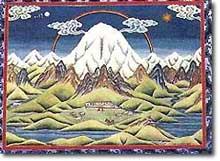
There are numerous sites in the region associated with Guru Rinpoche (Padmasambhava), whose tantric
Vajrayana
Vajrayāna Buddhism is also known as Tantric Buddhism, Tantrayāna, Mantrayāna, Secret Mantra, Esoteric Buddhism and the Diamond Vehicle...
practices in holy sites around Tibet are credited with finally establishing Buddhism as the main religion of the country in the 7th-8th century CE.
It is said that Milarepa
Milarepa
Jetsun Milarepa , is generally considered one of Tibet's most famous yogis and poets. He was a student of Marpa Lotsawa, and a major figure in the history of the Kagyu school of Tibetan Buddhism.- Life :...
(c. 1052-c. 1135 CE), champion of Tantric Buddhism, arrived in Tibet to challenge Naro Bön-chung, champion of the Bön religion of Tibet. The two magicians engaged in a terrifying sorcerers' battle, but neither was able to gain a decisive advantage. Finally, it was agreed that whoever could reach the summit of Kailash most rapidly would be the victor. While Naro Bön-chung sat on a magic drum
Drum
The drum is a member of the percussion group of musical instruments, which is technically classified as the membranophones. Drums consist of at least one membrane, called a drumhead or drum skin, that is stretched over a shell and struck, either directly with the player's hands, or with a...
and soared up the slope, Milarepa's followers were dumbfounded to see him sitting still and meditating. Yet when Naro Bön-chung was nearly at the top, Milarepa suddenly moved into action and overtook him by riding on the rays of the sun
Sunlight
Sunlight, in the broad sense, is the total frequency spectrum of electromagnetic radiation given off by the Sun. On Earth, sunlight is filtered through the Earth's atmosphere, and solar radiation is obvious as daylight when the Sun is above the horizon.When the direct solar radiation is not blocked...
, thus winning the contest. He did, however, fling a handful of snow on to the top of a nearby mountain, since known as Bönri, bequeathing it to the Bönpo and thereby ensuring continued Bönpo connections with the region.
In Bön
The Bön, a religion which predates Buddhism in Tibet, maintain that the entire mystical region and the nine-story SwastikaSwastika
The swastika is an equilateral cross with its arms bent at right angles, in either right-facing form in counter clock motion or its mirrored left-facing form in clock motion. Earliest archaeological evidence of swastika-shaped ornaments dates back to the Indus Valley Civilization of Ancient...
Mountain are the seat of all spiritual power
Tagzig Olmo Lung Ring
Tagzig Olmo Lung Ring is a non-dual spiritual realm of the Bon tradition which resides beyond dualism. It is understood to be a timeless perfected realm where peace and joy are the very fabric of being....
.
Pilgrimage
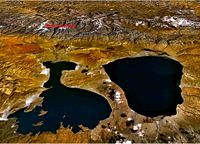
Pilgrimage
A pilgrimage is a journey or search of great moral or spiritual significance. Typically, it is a journey to a shrine or other location of importance to a person's beliefs and faith...
to Kailash, following a tradition going back thousands of years. Pilgrim
Pilgrim
A pilgrim is a traveler who is on a journey to a holy place. Typically, this is a physical journeying to some place of special significance to the adherent of a particular religious belief system...
s of several religions believe that circumambulating Mount Kailash on foot is a holy ritual that will bring good fortune. The peregrination is made in a clockwise direction by Hindus and Buddhists. Followers of the Jain and Bönpo religions circumambulate the mountain in a counterclockwise direction. The path around Mount Kailash is 52 km (32.3 mi) long.
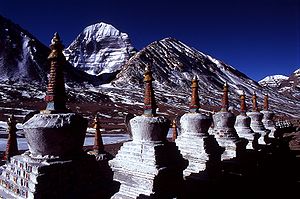
Altitude sickness
Altitude sickness—also known as acute mountain sickness , altitude illness, hypobaropathy, or soroche—is a pathological effect of high altitude on humans, caused by acute exposure to low partial pressure of oxygen at high altitude...
and harsh conditions faced in the process. Indeed, other pilgrims venture a much more demanding regimen, performing body-length prostration
Prostration
Prostration is the placement of the body in a reverentially or submissively prone position. Major world religions employ prostration either as a means of embodying reverence for a noble person, persons or doctrine, or as an act of submissiveness to a supreme being or beings...
s over the entire length of the circumambulation: The pilgrim bends down, kneels, prostrates full-length, makes a mark with his fingers, rises to his knees, prays, and then crawls forward on hands and knees to the mark made by his/her fingers before repeating the process. It requires at least four weeks of physical endurance to perform the circumambulation while following this regimen. The mountain is located in a particularly remote and inhospitable area of the Tibetan Himalayas. A few modern amenities, such as benches, resting places and refreshment kiosks, exist to aid the pilgrims in their devotions. According to all religions that revere the mountain, setting foot on its slopes is a dire sin. It is claimed that many people who ventured to defy the taboo have died in the process.It is a popular belief that the stairways on Mount Kailash lead to heaven.
Following the political and border disturbances
Origins of the Sino-Indian border dispute
Sovereignty over two separated pieces of territory was contested during the Sino-Indian War. One is Aksai Chin is located either in the Indian province of Kashmir or the Chinese province of Xinjiang in the west. It is a virtually uninhabited high-altitude wasteland crossed by the Xinjiang-Tibet...
across the Chinese-Indian boundary, pilgrimage to the legendary abode of Lord Shiva was stopped from 1954 to 1978. Thereafter, a limited number of Indian pilgrims have been allowed to visit the place, under the supervision of the Chinese and Indian governments either by a lengthy and hazardous trek over the Himalayan terrain, travel by land from Kathmandu or from Lhasa
Lhasa
Lhasa is the administrative capital of the Tibet Autonomous Region in the People's Republic of China and the second most populous city on the Tibetan Plateau, after Xining. At an altitude of , Lhasa is one of the highest cities in the world...
where flights from Kathmandu are available to Lhasa and thereafter travel over the great Tibetan plateau by car. The journey takes four night stops, finally arriving at Darchen
Darchen
Darchen,Tarchan or Taqin is a small village in Purang County of the Tibet Autonomous Region of China. It was previously known as Lhara and still signposted as such...
at elevation of 4600 m (15,091.9 ft), small outpost that swells with pilgrims at certain times of year. Despite its minimal infrastructure, modest guest houses are available for foreign pilgrims, whereas Tibetan pilgrims generally sleep in their own tents. A small regional medical center serving far-western Tibet and funded by the Swiss Ngari Korsum Foundation was built here in 1997.
Walking around the holy mountain—a part of its official park—has to be done on foot, pony
Pony
A pony is a small horse . Depending on context, a pony may be a horse that is under an approximate or exact height at the withers, or a small horse with a specific conformation and temperament. There are many different breeds...
or yak
Yak
The yak, Bos grunniens or Bos mutus, is a long-haired bovine found throughout the Himalayan region of south Central Asia, the Tibetan Plateau and as far north as Mongolia and Russia. In addition to a large domestic population, there is a small, vulnerable wild yak population...
, taking some three days of trekking starting from a height of around 15000 ft (4,572 m) past the Tarboche (flagpole) to cross the Drölma pass 18200 ft (5,547.4 m), and encamping for two nights en route. First, near the meadow of Dirapuk gompa, some 2 kilometre before the pass and second, after crossing the pass and going downhill as far as possible (viewing Gauri Kund
Gauri Kund
Gauri Kund is an important Hindu pilgrimage site on the way to Kedarnath, which is another nine miles uphill from there. It is situated at an altitude of more than 6000 feet in the Garhwal Himalayas. Kedarnath is one of the most sacred sites in Hinduism and it is dedicated to Lord Shiva. It is...
in the distance).
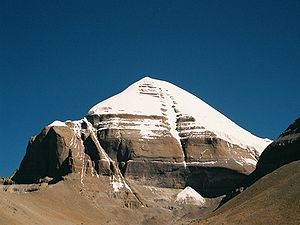
Mountaineering
Although Mount Kailash has never been climbed, a number of mountaineers have prospected the mountain with a view to climbing it. In 1926, Hugh RuttledgeHugh Ruttledge
Hugh Ruttledge was an English civil servant and mountaineer who was the leader of two expeditions to Mount Everest in 1933 and 1936.-Early life:...
studied the north face, which he estimated was 6,000 ft (1,800 m) high and "utterly unclimbable" and thought about an ascent of the north-east ridge, but he ran out of time. Ruttledge had been exploring the area with Colonel R. C. Wilson, who was on the other side of the mountain with his Sherpa named Satan. According to Wilson, Satan told Wilson, "'Sahib, we can climb that!' ... as he too saw that this [the SE ridge] represented a feasible route to the summit." Further excerpts from Wilson's article in the Alpine Journal
Alpine Journal
The Alpine Journal is the yearly publication of the Alpine Club of London. It is the oldest mountaineering journal in the world.-History:The journal was first published on 2 March 1863 by the publishing house of Longmans in London, with Hereford Brooke George as its first editor...
(vol. 40, 1928) show that he was utterly serious in his intention to climb Kailash, but, as with Ruttledge, he ran out of time.
Herbert Tichy
Herbert Tichy
Herbert Tichy was an Austrian author, geologist, journalist and climber.-Biography:In 1933 Tichy travelled with a motorcycle from Austria to India...
was in the area in 1936, attempting to climb Gurla Mandhata
Gurla Mandhata
Gurla Mandhata, or Naimona'nyi or Memo Nani is the highest peak of the Nalakankar Himal, a small subrange of the Himalaya. It lies in Burang County of the Ngari Prefecture in the Tibet Autonomous Region of China, near the northwest corner of Nepal. It is the 34th highest peak in the world...
. When he asked one of the Garpons of Ngari whether Kailash was climbable, the Garpon replied, "Only a man entirely free of sin could climb Kailas. And he wouldn't have to actually scale the sheer walls of ice to do it – he'd just turn himself into a bird and fly to the summit."
Reinhold Messner
Reinhold Messner
Reinhold Messner is an Italian mountaineer and explorer from Trentino-Alto Adige/Südtirol "whose astonishing feats on Everest and on peaks throughout the world have earned him the status of the greatest climber in history." He is renowned for making the first solo ascent of Mount Everest without...
was given the opportunity by the Chinese government to climb the mountain in the 1980s but he declined. In 2001 the Chinese gave permission for a Spanish team led by Jesus Martinez Novas to climb the peak, but in the face of international disapproval the Chinese decided to ban all attempts to climb the mountain. Messner, referring to the Spanish plans, said, "If we conquer this mountain, then we conquer something in people's souls ... I would suggest they go and climb something a little harder. Kailas is not so high and not so hard."
Further reading
- Allen, Charles. (1999). The Search for Shangri-LaShangri-LaShangri-La is a fictional place described in the 1933 novel Lost Horizon by British author James Hilton. Hilton describes Shangri-La as a mystical, harmonious valley, gently guided from a lamasery, enclosed in the western end of the Kunlun Mountains...
: A Journey into Tibetan History. Little, Brown and Company. Reprint: Abacus, London. 2000. ISBN 0-349-11142-1. - "A Tibetan Guide for Pilgrimage to Ti-se (Mount Kailas) and mTsho Ma-pham (Lake ManasarovarLake ManasarovarLake Manasarovar, Mapam Yumco , or Manasa Sarovar/Lake Manas , is a fresh-water lake in Tibet Autonomous Region of China approximately from Lhasa. To the west of Lake Manasa Sarovar is Lake Rakshastal and towards the north is Mount Kailash...
)." Toni Huber and Tsepak Rigzin. In: Sacred Spaces and Powerful Places In Tibetan Culture: A Collection of Essays. (1999) Edited by Toni Huber, pp. 125–153. The Library of Tibetan Works and Archives, Dharamsala, H.P., India. ISBN 81-86470-22-0. - Stein, R. A. (1961). Les tribus anciennes des marches Sino-Tibétaines: légends, classifications et histoire. Presses Universitaires de France, Paris. (In French)
- Johnson, Russell, and Moran, Kerry. (1989). The Sacred Mountain of Tibet: On Pilgrimage to Kailas. Park Street Press, Rochester, Vermont. ISBN 0-89281-325-3.
- Govinda, Lama Anagarika. (1966). The Way of the White Clouds: A Buddhist Pilgrim in Tibet. Shambhala Publications, Inc. Boulder, Colorado. Reprint with foreword by Peter Matthiessen: Shambhala Publications, Inc. Boston, Massachusetts. 1988. ISBN 0-87773-007-5
- Thubron, Colin. (2011). "To a Mountain in Tibet." Chatto & Windus, London. ISBN 9780701183806
External links
- Yoga around Kailash Video and still images illustrating the Pilgrimage route around Mt. Kailash and parts of Lake Manasarovar including the Saga Dawa "full moon festival" celebrating the life of the Buddha.
- Basic results of expedition to Kailash in the May 2010

